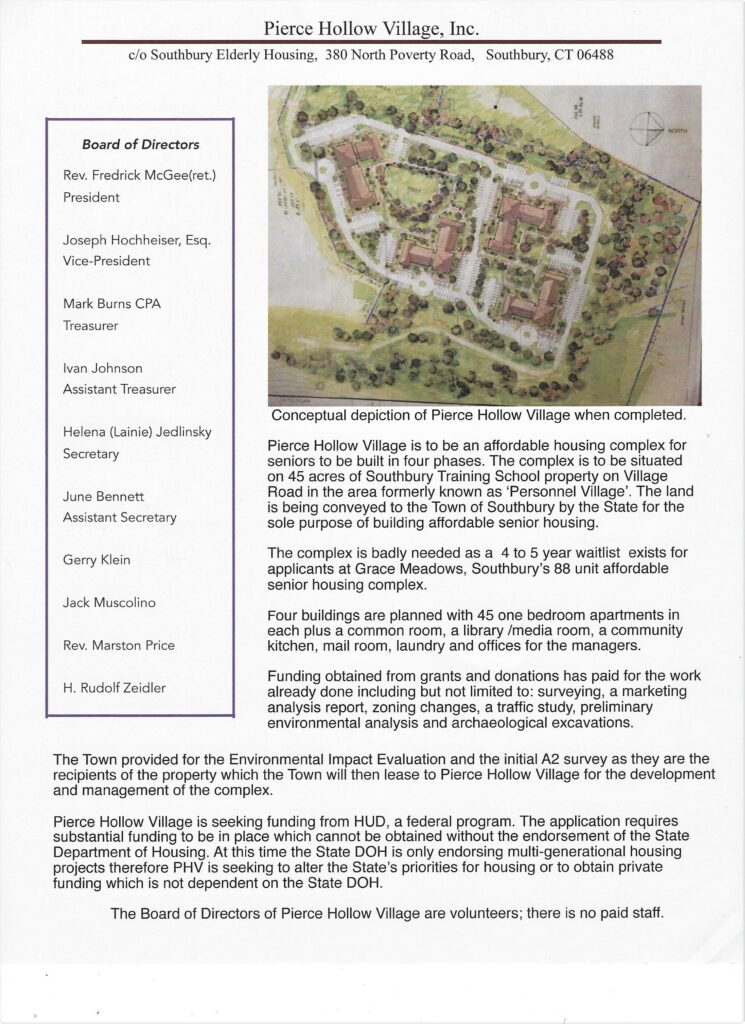
(This is one of three blogs on the Southbury Training School. The others cover the Southbury Farmlands and the Campus.)
Introduction
The Southbury Training School (STS) is the largest area in the 69th House District with an uncertain future. Due to a court decree, the school is set to close when the last current resident leaves or dies. My prior efforts (2011 – 2015) to forge a future for STS were successful. However more must be done. In this blog, I provide a brief background about STS, a summary of the effort to repurpose the Personnel Village and a way forward for the Personnel Village and Campus.
If elected, I will work to address the bureaucratic roadblocks that have prevented progress on repurposing the Personnel Village for workforce and senior affordable housing that will benefit all of the region.
Background
Groundbreaking for the Southbury Training School (STS) was in 1937 after the state bought several adjacent farms totaling 1,700 acres. It was sized to accommodate about 2,300 residents and employed about 2000 people.
At the time, Southbury and Roxbury were farming communities with very little housing for all of the new employees: Doctors, Therapists, Nurses and Administrators. To help address this, a Personnel Village was created on the property (East side of State Road 172) in 1955 for supervisory staff. There were two sections of single-family homes surrounding a common grass area on about 45 acres. Over time, other housing options were available, and the houses were repurposed for residents. However, most of the units were abandoned. (Here is a disturbing video made by people who trespass on the property which shows the condition of the buildings: Creepy and Haunted Abandoned Southbury Neighborhood )
In late 2012, I was approached by the Board of Directors of Grace Meadows, a Southbury Affordable Senior Housing development. I was already aware of their long waiting lists for those needing affordable housing and that they were looking for additional land. At that meeting, they asked if I, as First Selectman, would be willing to send a letter to the Governor requesting that the 45 acres be used for the future development of affordable senior housing. I was more than willing to send such a letter. The property had sewer and public water access, a real plus for this development. Others were also writing letters and moving things forward, including Representative Arthur O’Neil, who sponsored the legislation.
Sooner than expected, legislation was passed giving the Town of Southbury long-term use of the land for affordable senior housing. However, the legislation required additional work by the town (environmental impact evaluation and surveys as well as an archeological study) and waiting for the last current resident in the Personnel Village to leave. We did not want to appear that we were pushing people out of their homes.
Meanwhile, a new organization was formed to begin the work of raising money and creating plans for the 45 acres. The development was known as Pierce Hollow Village (PHV).

An important source of funding would be the State of Connecticut through the Department of Housing and the affiliated Housing Finance Authority. In 2015, PHV learned that funding for senior affordable housing was no longer a priority for the State. The priority was Multi-Generational Affordable Housing. I accompanied members of the Board to a meeting with the Department of Housing to see how we could move forward, but nothing was resolved at that meeting.
Since leaving the office of Frist Selectman in 2015, I have followed the work at Pierce Hollow Village. (In 2018, I conducted a television interview with PHV representatives to foster understanding of the status and impediments to progress.
In March of 2024, the Southbury Planning Commission recommended a way forward to the Board of Selectmen. The recommendation was to ask the State to change the wording of the legislation to allow projects that were either senior or multi-generational. I spoke in favor of this recommendation. The Board of Selectman raised numerous concerns that those who have studied affordable or work-force housing noted were misleading or showed a misunderstanding of what affordable housing means. One Selectman said that changing legislation would be difficult because of the complexity of the prior legislation. The Board scheduled a public meeting in February 2025 – well after the next legislative session would begin.
In speaking to the Lt. Governor about this, I was assured that such changes happen often and are not difficult.
To be clear, the decision on whether or not to accept a project at the Personnel Village property would remain with the Town of Southbury. At this point, there is no proposed project, just a recommendation to provide more flexibility in the legislation that could open up more sources of funding.
What Will I Do?
If elected, I will work to get the inconsistency between the Personnel Village legislation and the Connecticut Department of Housing resolved. As noted, this might involve changing legislation or looking at other approaches for funding the original Affordable Senior Housing.
As mentioned in my previous position paper on the STS Campus, one approach for the remaining property is to use the concept of a Development Authorities. The most well known and successful is the Capitol Region Development Authority in Harford (for more information go to Capital Region Development Authority). I met with the leaders of the CRDA along with Town of Southbury representatives and CRDA executive director agreed that this approach made sense as an effective way to chart a future for the STS campus, which could include the Personnel Village area. The CRDA includes commercial development, public facilities (convention center, science museum) and residential housing. Including the 45 acres of the Personnel Village might be a better approach to seeing this property developed in a way that is good for the Town, Region and State.
If elected, I will be in a position where the State can pursue these concepts and if appropriate (as I believe they are) move towards implementation.